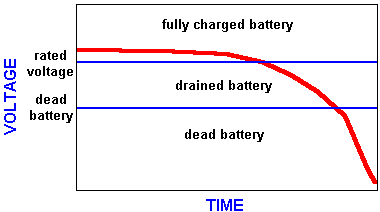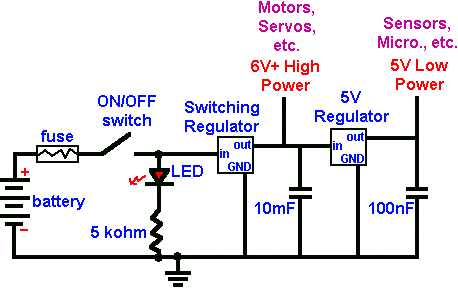
 Search Here
Search Here
MISC
Parts List
Robot Forum
Chat
Member Pages
Axon MCU
Robot Books
Shop
Contact
SKILLS
How To Build
A Robot
Tutorial
Calculators
Mechanics
Programming
Miscellaneous
Robots
Space
HARDWARE
Actuators
Batteries
Electronics
Materials
Microcontrollers
Sensors
SCIENCE
Robot Journals
Robot Theory
Conferences
The most important schematic to know, one that is almost always required for every robot whether you're a beginner or advanced, is a circuit to control your robots' power source. You cannot just hook up a battery directly to everything and expect it to work. Instead, there are three things that your power regulation circuit must do - regulate at a set voltage, supply a minimum required amount of required power at all times, and allow for additional special features/requirements of your application:
1) Regulate at a set voltage.
For efficiency, optimally it would be best to use a power source closest (yet slightly above) the desired voltage input required.
However this is rarely easy or even feasible.
For a start, different electronics require different voltages. A microcontroller
will require 5V, your motors perhaps 12V, a voltage amplifier perhaps both 20V and -20V.
Batteries are never at a constant voltage. A 6V battery will be at around 7V when fully charged, and can drop to 3-4V when drained. This below image shows how a typical battery voltage changes over time.

Microcontrollers (and especially sensors) are sensitive to the input voltage. Change the voltage, and funny (bad) things happen. To correct for this, you need to use an IC called a voltage regulator. What a voltage regulator does is take any input voltage and outputs a regulated voltage. So if your battery is at 7V, then a 5V regulator will output 5V and a lot of heat to dissipate the unused energy.
To calculate wasted power, use this equation:
(7V - 5V) * 200mA = .4W <- a lot wasted for a small robot!!!
(input_voltage - output_voltage) * current = wasted power
Since microcontrollers and sensors typically do not consume that much current, the wasted energy isnt that much. But for motors, this can be a huge problem. You do not want to over voltage them, but to regulate the voltage is a huge waste of energy. To correct for this, what you instead use is a switching regulator. They act just like a voltage regulator in terms of output, but are much much more efficient. If you need to regulate a 12V battery input for say a bunch of 6V servos, a switching regulator is the way to go. If your current voltage regulator overheats (melts, explodes, or requires ginormous heatsinks), then you should use a switching regulator. At the time of this writing, the best switching regulator I have found can be bought at dimensionengineering.com.
2) Supply a minimum required amount of power.
The sum required power of all your robot components needs to be below the amount your power
circuit can supply. If power drops even for a fraction of a second below what your robot requires,
things like the microcontroller could reset, or sensors would give bad readings, or motors wont work very well.
In plain english:
Energy required by robot < energy battery can supply <- good!
Energy required by robot > energy battery can supply <- bad! you deserve to die!
How to solve this problem? Easy. Determine how much total power your robot will require by experimenting, calculating equations, and looking up datasheets on the parts you use.
- power = voltage * current
If your battery can supply 8 amps continuous, and your robot at worst case scenario only requires 7 amps, then you are fine. But there are occasions when your robot may require huge amounts of current (like a motor suddenly reversing while going full speed) that your battery source cant handle. To correct for this, what you want is a seperate 'quick release' energy reserve - a large electrolytic capacitor. You can use a capacitor to store up large quantities of energy during idle periods, and it can release all that energy nearly at once when your robot needs it most. An example of a capacitor being used for such a situation can be found in my H-bridge schematic.
3) Allow for additional features/requirements, such as short circuit protection, regeneration, negative voltages, and noise protection.
If something bad goes wrong with your batteries, things like acid chemical spilling, dangerous fires,
or the end of the world could happen. Your circuit needs to account for this. Use fuses!!!
Some motor drivers have a feature for regeneration, meaning some power can be used to recharge your power supply. Using a capacitor as described in part 2 above is more efficient than using a battery for regeneration, simply because batteries have a higher charging resistance.
If you require negative voltages, view the negative voltage generator tutorial.

One problem your circuit may have is high frequency noise (bad). High frequency noise can result from common things such as el-cheapo and/or old motors (the brushes have bad connections), RF interference, and telepathic aliens. To correct for this, you want to use another capacitor but of a much smaller farad rating. Part 2 above describes using large capacitors for preventing low frequency voltage disturbances, so this time you will use a small capacitor (~10-100nF) for preventing high frequency disturbances.
What you have been waiting for all this time -
The robot power regulation schematic!

* A note on this schematic. Switching regulators have a voltage drop of 1-2V, and linear regulators have a similar voltage drop. If this is a problem, attach the linear regulator input to the switching regulator input line (not output).
Society of Robots copyright 2005-2014